Abstract
In this paper, we study the mean-square exponential input-to-state stability (exp-ISS) problem for a new class of neural network (NN) models, i.e., continuous-time stochastic memristive quaternion-valued neural networks (SMQVNNs) with time delays. Firstly, in order to overcome the difficulties posed by non-commutative quaternion multiplication, we decompose the original SMQVNNs into four real-valued models. Secondly, by constructing suitable Lyapunov functional and applying It ’s formula, Dynkin’s formula as well as inequity techniques, we prove that the considered system model is mean-square exp-ISS. In comparison with the conventional research on stability, we derive a new mean-square exp-ISS criterion for SMQVNNs. The results obtained in this paper are the general case of previously known results in complex and real fields. Finally, a numerical example has been provided to show the effectiveness of the obtained theoretical results.
1. Introduction
In 1971, Chua proposed the theoretical idea of memristor [1], and its prototype was produced by the HP lab successfully in 2008 [2,3]. A memristor is the fourth fundamental element of an electrical circuit that can be used to construct a new artificial neural network. It has a tremendous potential to be utilized in synapsis for simulation of the human brain by replacing a resistor with a memristor [4,5,6]. In view of these characteristics, a new neural network (NN) model, namely, the memristive neural network (MNN) has been widely studied, and many theoretical papers regarding various dynamics of MNNs have been published in recent years [7,8,9,10,11,12,13]. From the real-world application perspective, time delays inherently arise in many practical systems including NNs. Indeed, time delays appear as the main cause of instability, compromising the system performance in real environments [10,14,15,16,17,18]. Typically, two main types of time delays exist, i.e., either constant delays or time-varying delays. The time-varying delays can be viewed as a general case of constant time delays. Up to now, a number of investigations with respect to the dynamics of NN models along with time-varying delays are available in the literature [10,15,16,17,18,19,20,21].
It has been reported that real-valued neural networks (RVNNs) are useful in various scientific fields, for example, optimization, image and signal processing, as well as associative memory [10,16,17]. However, RVNN models perform poorly in tackling the XOR problem and in 2D affine transformations [18,19]. In view of this, complex properties have been incorporated into RVNNs to formulate complex-valued neural networks (CVNNs), which can effectively solve the XOR problem and affine transformations [18,19]. As a result, CVNN-related models have received significant research attention in both mathematical and practical analyses [20,21,22,23,24]. Nevertheless, CVNN models are inefficient in handling higher dimension transformations including color night vision, color image compression, and and problems [25,26,27]. Meanwhile, several engineering problems involve quaternion-valued signals and quaternion functions, such as 3D wind forecasting, polarized signal classification, color night vision, as well as color night vision [26,27,28]. Undoubtedly, quaternion-based networks present good mathematical models to undertake these applications due to the quaternion features. In view of this, quaternion-valued neural networks (QVNNs) have been developed by implementing quaternion algebra into CVNNs, in order to generalize RVNN and CVNN models with quaternion-valued activation functions, connection weights, as well as signals states [11,29,30,31,32]. Therefore, the investigation of the dynamics of QVNN models is essential and important. Recently, many computational approaches for various QVNN models and their learning algorithms have been proposed. Among the studies include global stability, global asymptotic stability as well as global synchronization [29,30,31]. Other studies of QVNN models are also available, for example, exponential input-to-state stability (exp-ISS) and global Mittag-Leffler stability and synchronization [32,33]. Similarly, some other stability conditions have been defined for QVNN models [12,34,35].
In modeling problems, we have to consider the existence of noise, since it is inherent in nonlinear dynamic systems. In fact, when a system is influenced by external disturbance, the stochastic neural network (SNN) models become very useful for describing a real system, as compared with a deterministic NN. Therefore, it is crucial to examine the dynamic properties pertaining to SNN models. As a result, several research studies have extensively analyzed the dynamics of SNN models [36,37], stochastic Hopfield NN models [38], stochastic memristive NN models [13], and stochastic CVNN models [13]. On the other hand, it is clear that the external inputs can influence the dynamic behaviors of NNs in practical applications. As such, the ISS criterion is important to characterize the effects of external inputs [10,39,40]. Recently, several useful ISS results for stochastic RVNN and CVNN models have been published [13,39,40,41]. It should be noted that most studies on QVNN dynamic behaviors are concerned with global asymptotic stability and synchronization analysis [11,29,30,31,32]. There are only a few studies on the exponential stability of QVNN models. According to our survey, the study on mean-square exp-ISS analysis with respect to SMQVNN models with time-varying delays is new in the literature, and our paper contributes toward this research area.
Inspired by the above-mentioned discussions, our analysis mainly focuses on the mean-square exp-ISS problem for the SMQVNN models. The current SMQVNN model encompasses stochastic memristive CVNN and stochastic memristive RVNN as its special cases. We divide the original QVNN into four RVNN models, in order to avoid the issue of non-commutative of quaternion multiplication. By constructing suitable Lyapunov functional and utilizing Dynkin’s and It ’s formulae, as well as other inequality methods, we establish new sufficient conditions for exp-ISS with respect to the considered SMQVNN model. We illustrate the usefulness of the obtained results by a numerical example.
This study has the following contributions: (1) this is the first analysis on the mean-square exp-ISS pertaining to SMQVNN models with time-varying delays; (2) unlike the conventional stability criteria, we establish new mean-square exp-ISS pertaining to the SMQVNN by dividing the original QVNN into four RVNN models; (3) the main results of this paper are new and more general than those in the QVNN literature.
This paper is structured as follows. We formally define the proposed model and analyze the new exp-ISS criteria in Section 2 and Section 3, respectively. We present the numerical example and the associated simulation results in Section 4. In Section 5, we present the key conclusions and some suggestions for future research.
2. Mathematical Fundamentals and Problem Formulation
2.1. Mathematical Notations
The real field, complex field, and skew field of quaternion are denoted as , and , respectively. Their n-dimension vector with elements of and are denoted as and , while their matrices with entries from and are denoted as and , respectively. In addition, the space of a continuous function mapping from into is denoted as . The closure of the convex hull of , which is formulated from quaternion numbers ∇ and ∆, is denoted as . A class of essentially bounded function u from to with is denoted as , while the family of all measurable is denoted as . Besides that, -valued stochastic variables is in a way that , in which the mathematical expectation operation pertaining to a probability measure is denoted as . Superscripts * and T represent the complex conjugate transpose and matrix transposition, while represent the imaginary units, respectively, and .
2.2. Quaternion Algebra
Firstly, we address the quaternion and its operating rules. We can express the quaternion, which consists of a real part along and three imaginary parts, as:
where . The multiplication rules of Hamilton are satisfied by the imaginary roots :
The quaternion-valued function is denoted by , where , , , . Let and are two quaternions, the addition and subtraction of are defined as
We can express the product of with respect to the multiplication rules of Hamilton as:
Note that given any , represents the norm of , while represents the modulus of , in which the conjugate transpose of is denoted as .
2.3. Problem Formation
In this section, we define a SMQVNN model as:
Subject to the initial condition of
where is a constant and the state variable is ; the external input vector is . In addition, the time delay is , which is differentiable and it is able to satisfy , with positive constants and ; is the initial condition. In addition, and are quaternion-valued activation functions. The standard Brownian motion is denoted by . Note that it is defined on a probability space of subject to a natural filtration . Besides that, is a Borel measurable function; while the quaternion-valued connection weights are and , which can be expressed as:
with is the capacitor, and are the memductances of memristors and , respectively, that represent a memristor from and and a memristor from and . Based on the memristor current-voltage properties, the memristive connection weights are chosen to be state-dependent switching as follows:
for , the switching jumps , and, where , , , , , , , and , , , , , , , , , are constants.
A1: [32] For any , and are bounded and continuous along with positive constants , such that
for all and , .
Remark 1.
The activation functions are the fundamental factors in the structure of the NN model. The choice of appropriate quaternion-valued activation functions remains an open question in the QVNNs study. Recently, several activation functions have recently been used to study QVNNs. For example, nonmonotonic piecewise nonlinear activation functions, linear threshold activation functions, and real-imaginary separate type activation functions. The main results of this paper will be derived based on the assumption A1 that the activation functions can be divided into real and imaginary parts.
As similar in [13,41], by using the set valued map as well as the differential inclusion theory, from Equation (2), we obtain
or equivalently, for all , where , , , . There exist measurable functions , , such that
Now, let , , , , , , , , , , , , , , , . We assume that the NN model (6) can be separated into real and imaginary parts. Therefore, there exist measurable functions , , , , , , , , such that the NN model (6) can be express as follows:
for , where , , , , , and
Consider Model (7), its initial condition is
for where , , , .
A2: [32] For any , and are bounded and continuous, along with , as the positive constants, in which
for all and , .
Let , , , , , , , , , , , , , , , , , , , , , , , , , , , , .
Now, we can express Model (7) as
Denote
Therefore, the model in Equation (10) can be rewritten as
Note that the model in Equation (11) has the following initial condition
where , with , .
A3: [13] There exist nonnegative constants , such that
for all , , , .
A4: [13] , , , , for all .
Definition 1.
[13] There existence of positive scalars , the SMQVNN model in Equation (2) has a trivial solution that is mean-square exp-ISS, in which
for any .
Now, consider the initial data on in has the solution of . Obviously, under assumptions A2 and A4, subject to the input , the model in Equation (11) has a trivial solution, or a zero solution .
3. Main Results
We derive the sufficient conditions that assure the mean-square exp-ISS with respect to the trivial solution of the SMQVNN model in Equation (2).
Theorem 1.
Suppose that A1–A4 hold, subject to the existence of positive scalars , , the SMQVNN model in Equation (2) has a trivial solution, which is mean-square exp-ISS, in which
Proof.
A Lyapunov functional is formulated as
where
Then,
where
Based on the It ’s formula, we have
where
where the It ’s operator is , such that
According to A2 and A3, we have
By using similar techniques, we can estimate the derivatives of and along the solution with respect to the model in Equation (7) as
Using the well-known Young inequality, it follows that
Substituting the above inequalities into Equations (26)–(29), we have
With further simplification, we have
where
According to Equations (14)–(21), we can easily obtain
Now, similar to the study in [13], the Markov time or stopping time is defined as . The Dynkin formula is then used to yield
With respect to the monotone convergence theorem, we have the following when ℏ goes to ∞
Based on Equation (22), we have
Combining Equations (37) and (38), we have
Consequently, we can derive
where
which implies that the SMQVNN model in Equation (2) has a trivial solution, which is mean-square exp ISS. The proof is completed. □
Remark 2.
Suppose that the time-varying delay is assumed to satisfy , where τ is a positive real constant. As we mentioned in the introduction, constant delays can be seen as a special case of time-varying delays when the delays vary in a fixed point. Therefore, the mean-square exp-ISS criterion of the NN Model (2) can be derived based on the same approaches as in Theorem (1) with constant delays in the following Corollary (1).
Corollary 1.
Suppose that A1-A4 hold, and subject to the existence of positive scalars , , the SMQVNN model in Equation (2) with a constant delay has a trival solution, which is mean-square exp-ISS, in which
Remark 3.
The exp-ISS criteria pertaining to the SMQVNN model is yet to be reported in the study of QVNNs dynamics. In order to fill this gap, Theorem (1) and Corollary (1) reveal several new sufficient conditions for the SMQVNN model.
Based on the complex number definition, the model in Equation (10) becomes:
Corollary 2.
Suppose that A1-A4 hold, and subject to the existence of positive scalars , , the SMCVNN model in Equation (49) has a trivial solution that is the mean-square exp ISS, such that
Remark 4.
When the external inputs , , and in Equation (10) are bounded, then is bounded in Equation (12). From Equation (40), we can acquire that is bounded. Therefore, the model in Equation (2) is stable with respect to a bounded input bounded output (BIBO) condition subject to validity of the conditions of Equations (14)–(21).
Remark 5.
In [39,40], the authors have studied the exp-ISS stability criteria for a class of stochastic RVNNs. Recently, in [13,41], the authors have extended the results proposed in [39,40], to the complex domain. The exp-ISS stability criteria for stochastic CVNNs has also been analyzed. Compared to the previous results, in this paper, we have generalized the results proposed in [13,39,40,41] to the quaternion domain. Furthermore, the results obtained in previous studies [13,39,40,41] can be seen as special cases of this paper.
4. Illustrative Examples
A simulation example is presented to ascertain the efficiency of the results.
Example 1.
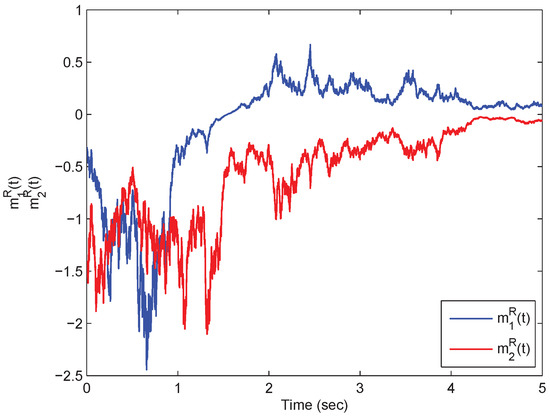
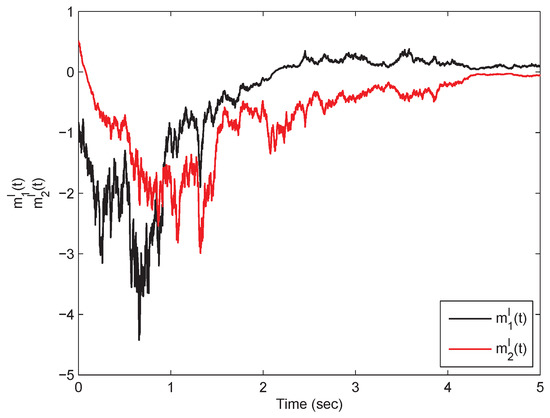
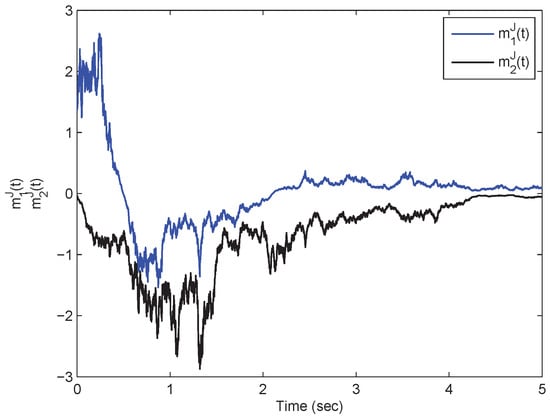
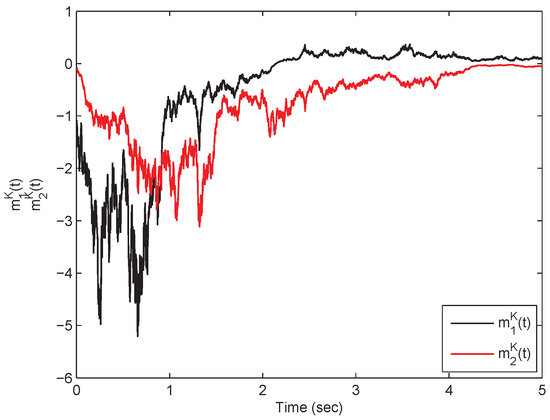
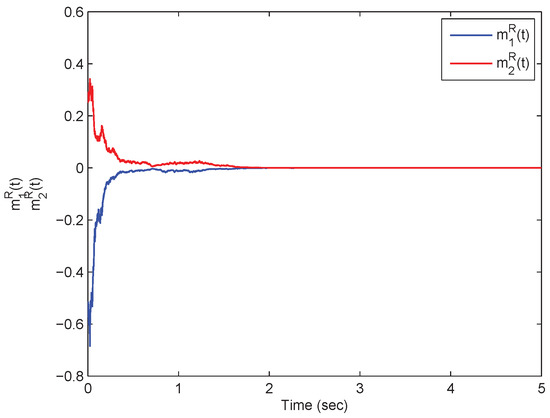
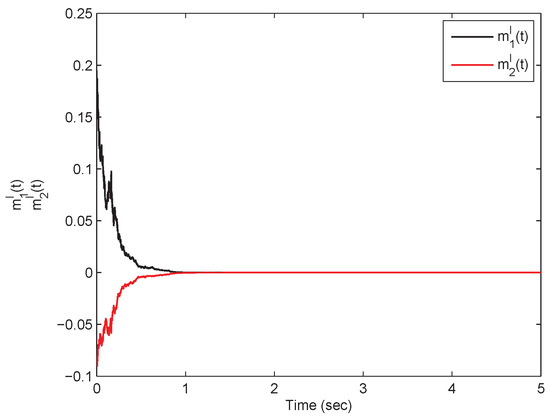
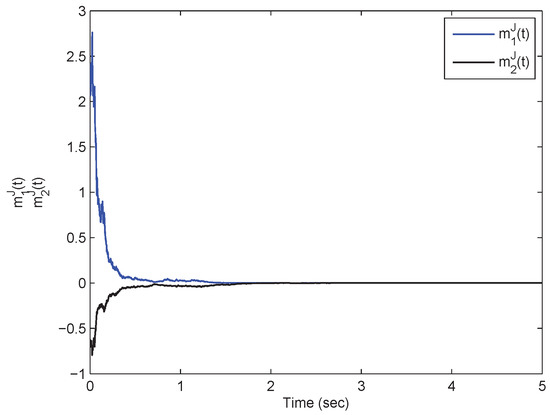
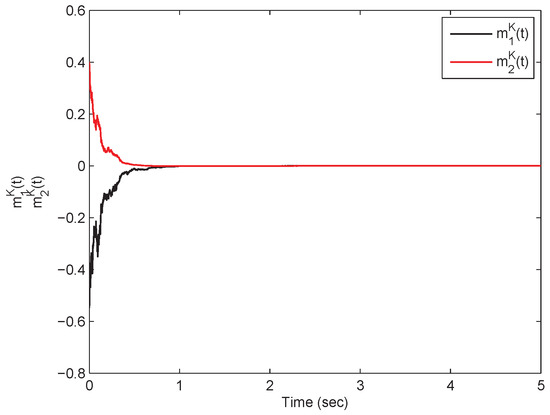
A 2D SMQVNN model with a time-varying delay is considered as follows:
where
and , . The the activation functions and external input are as follows and
According to the above analysis, we have , where
Take, , , , . By simple computation, the following conditions as given in Equations (55)–(62) are true for all .
From Theorem (1), it is clear that the model in Equation (54) is mean-square exp-ISS. Referring to the model in Equation (54) in the presence of inputs, its state responses with respect to the real and imaginary parts are plotted in Figure 1, Figure 2, Figure 3 and Figure 4. On the other hand, the model in Equation (54) in the absence of the inputs has the state responses with respect to the real and imaginary parts shown in Figure 5, Figure 6, Figure 7 and Figure 8. Therefore, it is clear that the model in Equation (54) is mean-square exponentially stable.

Figure 1.
A time response plot with respect to the states pertaining to the SMQVNN model in Equation (54) in which .

Figure 2.
A time response plot with respect to the states pertaining to the SMQVNN model in Equation (54) in which .

Figure 3.
A time response plot with respect to the states pertaining to the SMQVNN model in Equation (54) in which .

Figure 4.
A time response plot with respect to the states pertaining to the SMQVNN model in Equation (54) in which .

Figure 5.
A time response plot with respect to the states pertaining to the SMQVNN model in Equation (54) in which .

Figure 6.
A time response plot with respect to the states pertaining to the SMQVNN model in Equation (54) in which .

Figure 7.
A time response plot with respect to the states pertaining to the SMQVNN model in Equation (54) in which .

Figure 8.
A time response plot with respect to the states pertaining to the SMQVNN model in Equation (54) in which .
5. Summary
In this paper, we have studied the mean-square exponential input-to-state stability problem for a new class of SMQVNNs with time-varying delays. Firstly, we decomposed the original SMQVNNs into four real-valued models, in order to avoid the difficulties posed by non-commutative quaternion multiplication. Secondly, by constructing suitable Lyapunov functional and applying It ’s formula, Dynkin’s formula as well as inequity techniques, several new sufficient conditions have been obtained to guarantee that the considered system model is mean-square exp-ISS. The results obtained in this paper are the general case of previously known results in complex and real fields. Finally, a numerical example shows the effectiveness of the obtained theoretical results.
Based on the proposed method in this paper, it is possible to analyze different QVNN models. The proposed approach can be applied to the analysis of stochastic QVNN models for the discrete-time case. In future studies, the stability and synchronization analysis for discrete-time stochastic QVNN models will also be investigated. The results will be useful for the dynamical analysis of discrete-time stochastic QVNN models.
Author Contributions
Conceptualization, G.R.; Data curation, G.R.; Formal analysis, G.R.; Funding acquisition, U.H.; Investigation, G.R.; Methodology, G.R.; Software, P.K., P.C., R.S. (Ramalingam Sriraman) and R.S. (Rajendran Samidurai); Supervision, C.P.L.; Validation, G.R.; Writing—original draft, G.R.; Writing—review and editing, G.R. All authors have read and agreed to the published version of the manuscript.
Funding
This research is made possible through financial support of King Mongkut’s University of Technology Thonburi (KMUTT) and the Thailand research Grant Fund (RSA6280004).
Acknowledgments
The authors acknowledge King Mongkut’s University of Technology Thonburi for funding Postdoctoral Fellowship to Pramet Kaewmesri and the Thailand research Grant Fund (RSA6280004). The authors are very grateful to the Department of Mathematics, Faculty of Science, King Mongkut’s University of Technology Thonburi (KMUTT) for all support.
Conflicts of Interest
The authors declare no conflict of interest.
References
- Chua, L. Memristor: The missing circuit element. IEEE Trans. Circuits Theory 1971, 18, 507–519. [Google Scholar] [CrossRef]
- Strukov, D.; Snider, G.; Stewart, D.; Williams, R. The missing memristor found. Nature 2008, 453, 80–83. [Google Scholar] [CrossRef] [PubMed]
- Tour, J.; He, T. The fourth element. Nature 2008, 453, 42–43. [Google Scholar] [CrossRef] [PubMed]
- Adhikari, S.; Yang, C.; Kim, H.; Chua, L. Memristor bridge synapse-based neural network and its learning. IEEE Trans. Neural Netw. Learn. Syst. 2012, 23, 1426–1435. [Google Scholar] [CrossRef] [PubMed]
- Li, T.; Duan, S.; Liu, J.; Wang, L.; Huang, T. A spintronic memristor-based neural network with radial basis function for robotic manipulator control implementation. IEEE Trans. Syst. Man Cybern. Syst. 2016, 46, 582–588. [Google Scholar] [CrossRef]
- Duan, S.; Hu, X.; Dong, Z.; Wang, L.; Mazumder, P. Memristor-based cellular nonlinear/neural network: Design, analysis and applications. IEEE Trans. Neural Netw. Learn. Syst. 2015, 26, 1202–1213. [Google Scholar] [CrossRef] [PubMed]
- Zhang, Z.; Liu, X.; Zhou, D.; Lin, C.; Chen, J.; Wang, H. Finite-time stabilizability and instabilizability for complex-valued memristive neural networks with time delays. IEEE Trans. Syst. Man Cybern. Syst. 2018, 48, 2371–2382. [Google Scholar] [CrossRef]
- Liu, D.; Zhu, S.; Chang, W. Global exponential stability of stochastic memristor-based complex-valued neural networks with time delays. Nonlinear Dyn. 2017, 90, 915–934. [Google Scholar] [CrossRef]
- Zhong, K.; Zhu, S.; Yang, Q. Further results for global exponential stability of stochastic memristor-based neural networks with time-varying delays. Int. J. Syst. Sci. 2015, 47, 3573–3580. [Google Scholar] [CrossRef]
- Wu, A.; Zeng, Z. Input-to-state stability of memristive neural system with time delays. Circuits Syst. Signal Process. 2014, 33, 681–698. [Google Scholar] [CrossRef]
- Xiao, J.; Zhong, S. Synchronization and stability of delayed fractional-order memristive quaternion-valued neural networks with parameter uncertainties. Neurocomputing 2019, 363, 321–338. [Google Scholar] [CrossRef]
- Pratap, A.; Raja, R.; Alzabut, J.; Dianavinnarasi, J.; Cao, J.; Rajchakit, G. Finite-time Mittag-Leffler stability of fractional-order quaternion-valued memristive neural networks with impulses. Neural Process. Lett. 2019, 51, 1485–1526. [Google Scholar] [CrossRef]
- Liu, D.; Zhu, S.; Chang, W. Mean square exponential input-to-state stability of stochastic memristive complex-valued neural networks with time varying delay. Int. J. Syst. Sci. 2017, 48, 1–12. [Google Scholar] [CrossRef]
- Kwon, O.M.; Park, J.H. New delay-dependent robust stability criterion for uncertain neural networks with time-varying delays. Appl. Math. Comput. 2008, 205, 417–427. [Google Scholar] [CrossRef]
- Liu, Y.; Lee, S.M.; Kwon, O.M.; Park, J.H. New approach to stability criteria for generalized neural networks with interval time-varying delays. Neurocomputing 2015, 149, 1544–1551. [Google Scholar] [CrossRef]
- Kwon, O.M.; Park, J.H. Exponential stability analysis for uncertain neural networks with interval time-varying delays. Appl. Math. Comput. 2009, 212, 530–541. [Google Scholar] [CrossRef]
- Kwon, O.M.; Park, J.H. Delay-dependent stability for uncertain cellular neural networks with discrete and distribute time-varying delays. J. Franklin Inst. 2008, 345, 766–778. [Google Scholar] [CrossRef]
- Hirose, A. Complex-Valued Neural Networks: Theories and Applications; World Scientific: Singapore, 2003. [Google Scholar]
- Nitta, T. Solving the XOR problem and the detection of symmetry using a single complex-valued neuron. Neural Netw. 2003, 16, 1101–1105. [Google Scholar] [CrossRef]
- Goh, S.L.; Chen, M.; Popovic, D.H.; Aihara, K.; Obradovic, D.; Mandic, D.P. Complex-valued forecasting of wind profile. Renew. Energy 2006, 31, 1733–1750. [Google Scholar] [CrossRef]
- Samidurai, R.; Sriraman, R.; Cao, J.; Tu, Z. Effects of leakage delay on global asymptotic stability of complex-valued neural networks with interval time-varying delays via new complex-valued Jensen’s inequality. Int. J. Adapt. Control Signal Process. 2018, 32, 1294–1312. [Google Scholar] [CrossRef]
- Guo, R.; Zhang, Z.; Liu, X.; Lin, C. Existence, uniqueness, and exponential stability analysis for complex-valued memristor-based BAM neural networks with time delays. Appl. Math. Comput. 2017, 311, 100–117. [Google Scholar] [CrossRef]
- Zhang, Z.; Liu, X.; Guo, R.; Lin, C. Finite-time stability for delayed complex-valued BAM neural networks. Neural Process. Lett. 2018, 48, 179–193. [Google Scholar] [CrossRef]
- Pratap, A.; Raja, R.; Cao, J.; Rajchakit, G.; Lim, C.P. Global robust synchronization of fractional order complex-valued neural networks with mixed time-varying delays and impulses. Int. J. Control Autom. Syst. 2019, 17, 509–520. [Google Scholar]
- Kusamichi, H.; Isokawa, T.; Matsui, N.; Ogawa, Y.; Maeda, K. A new scheme for color night vision by quaternion neural network. In Proceedings of the ICARA, Palmerston North, New Zealand, 13–15 December 2004; pp. 101–106. [Google Scholar]
- Isokawa, T.; Nishimura, H.; Kamiura, N.; Matsui, N. Associative memory in quaternionic Hopfield neural network. Int. J. Neural Syst. 2008, 18, 135–145. [Google Scholar] [CrossRef] [PubMed]
- Matsui, N.; Isokawa, T.; Kusamichi, H.; Peper, F.; Nishimura, H. Quaternion neural network with geometrical operators. J. Intell. Fuzzy Syst. 2004, 15, 149–164. [Google Scholar]
- Mandic, D.P.; Jahanchahi, C.; Took, C.C. A quaternion gradient operator and its applications. IEEE Signal Proc. Lett. 2011, 18, 47–50. [Google Scholar] [CrossRef]
- Li, H.L.; Jiang, H.; Cao, J. Global synchronization of fractional-order quaternion-valued neural networks with leakage and discrete delays. Neurocomputing 2019, 385, 211–219. [Google Scholar] [CrossRef]
- Tu, Z.; Zhao, Y.; Ding, N.; Feng, Y.; Zhang, W. Stability analysis of quaternion-valued neural networks with both discrete and distributed delays. Appl. Math. Comput. 2019, 343, 342–353. [Google Scholar] [CrossRef]
- You, X.; Song, Q.; Liang, J.; Liu, Y.; Alsaadi, F.E. Global μ-stability of quaternion-valued neural networks with mixed time-varying delays. Neurocomputing 2018, 290, 12–25. [Google Scholar] [CrossRef]
- Yang, X.; Li, C.; Song, Q.; Chen, J.; Huang, J. Global Mittag-Leffler stability and synchronization analysis of fractional-order quaternion-valued neural networks with linear threshold neurons. Neural Netw. 2018, 105, 88–103. [Google Scholar] [CrossRef]
- Qi, X.; Bao, H.; Cao, J. Exponential input-to-state stability of quaternion-valued neural networks with time delay. Appl. Math. Comput. 2019, 358, 382–393. [Google Scholar] [CrossRef]
- Tu, Z.; Yang, X.; Wang, L.; Ding, N. Stability and stabilization of quaternion-valued neural networks with uncertain time-delayed impulses: Direct quaternion method. Physica A Stat. Mech. Appl. 2019, 535, 122358. [Google Scholar] [CrossRef]
- Xiao, J.; Wen, S.; Yang, X.; Zhong, S. New approach to global Mittag-Leffler synchronization problem of fractional-order quaternion-valued BAM neural networks based on a new inequality. Neural Netw. 2020, 122, 320–337. [Google Scholar] [CrossRef] [PubMed]
- Li, B.; Xu, D. Mean square asymptotic behavior of stochastic neural networks with infinitely distributed delays. Neurocomputing 2009, 72, 3311–3317. [Google Scholar] [CrossRef]
- Xu, X.; Zhang, J.; Zhang, W. Mean square exponential stability of stochastic neural networks with reaction-diffusion terms and delays. Appl. Math. Lett. 2011, 24, 5–11. [Google Scholar] [CrossRef]
- Zhou, Q.; Wan, L. Exponential stability of stochastic delayed Hopfield neural networks. Appl. Math. Comput. 2008, 199, 84–89. [Google Scholar] [CrossRef]
- Zhu, Q.; Cao, J. Mean-square exponential input-to-state stability of stochastic delayed neural networks. Neurocomputing 2014, 131, 157–163. [Google Scholar] [CrossRef]
- Shu, Y.J.; Liu, X.G.; Wang, F.X.; Qiu, S.B. Exponential input-to-state stability of stochastic neural networks with mixed delays. Int. J. Mach. Learn. Cyber. 2018, 9, 807–819. [Google Scholar] [CrossRef]
- Song, Y.; Sun, W.; Jiang, F. Mean-square exponential input-to-state stability for neutral stochastic neural networks with mixed delays. Neurocomputing 2016, 205, 195–203. [Google Scholar] [CrossRef]
© 2020 by the authors. Licensee MDPI, Basel, Switzerland. This article is an open access article distributed under the terms and conditions of the Creative Commons Attribution (CC BY) license (http://creativecommons.org/licenses/by/4.0/).